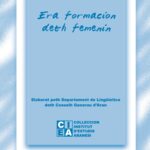| book-author | |
|---|---|
| format |
Mirèlha (Occitan Provençau)
0,00 €
Customer Reviews
There are no reviews yet.

Per toti es publicacions
Pes libres en format papèr
En lengua occitana
Tòn equipa ath tòn servici
La langue d’oc ou occitan représente, à coté du catalan, du français, du francoprovencal, du castillan, [.] une des grandes langues romanes ou néo-latines qui se sont développées a partir d’une symbiose entre le latin populaire.
Pierre Bec ei professeur à l’Université de Poitiers, ancien Président de l’Institut d’Etudes Occitanes, ancien Directeur du Centre d’Etudes Supérieures de Civilisation Médiévale.
From Petrarch and Dante to Pound and Eliot, the influence of the troubadours on European poetry has been profound. They have rightly stimulated a vast amount of critical writing, but the majority of modern critics see the troubadour tradition as a corpus of earnestly serious and confessional love poetry, with little or no humour. Troubadours and Irony re-examines the work offiveearly troubadours, namely Marcabru, Bernart Marti, Peire d’Alvernha, Raimbaut d’Aurenga and Giraut de Borneil, to argue that the courtly poetry of Southern France in the twelfth century was permeated with irony and that many troubadour songs were playful, laced with humorous sexual innuendo and far from serious; attention is also drawn to the large corpus of texts that are not love poems, but comic or satirical songs. New interpretations of many problematic troubadour poems are offered; in some cases the received view of a troubadour’s work is questioned. New perspectives on the tradition as a whole are suggested, and consequently on courtly culture in general. The author addresses the philological problems, by no means negligible, posed by the texts in question, and several poems are re-edited from the manuscripts.
The medieval troubadours of the South of France profoundly influenced European literature for many centuries. This book is the first full-length study of the first-person subject position adopted by many of them in its relation to language and society. Using modern theoretical approaches, Sarah Kay discusses to what extent this first person is a “self” or “character,” and how far it is self-determining. Kay draws on a wide range of troubadour texts, providing many close readings and translating all medieval quotations into English. Her book will be of interest both to scholars of medieval literature, and to anyone investigating subjectivity in lyric poetry.
“Singing to another tune” is from Las Leys d’amors (The Laws of Love), a poetic treatise compiled by Guilhem Molinier in the first half of the fourteenth century. Guilhem’s phrase pertains to a compositional technique known to modern scholars as contrafacture, in which the troubadour fashions new lyrics after the poetic structure of a preexistent song, thereby allowing his work to be sung to the earlier melody. The technique of contrafacture is documented not only by Guilhem and contemporaneous theorists but also by the troubadours themselves, who on a number of occasions acknowledge composing a poem “el so de,” or “to the tune of” another composer. Both theory and practice demonstrate that structural imitation came to be most closely associated with several specific genres, including the sirventes (moralizing piece), tenso (debate song), coblas (song of few strophes), and planh (lament), their poetic structures commonly modeled after those of the canso, the dominant genre of troubadour composition. Despite abundant structural indications of contrafacture within the troubadour repertoire, melodic traces of the practice are surprisingly scant. Confirmation of melodic borrowing depends upon the preservation of a model and its contrafactum with their concordant musical readings, yet the small proportion of surviving troubadour melodies (with only one in ten lyric texts transmitted with its tune) poses a significant impediment to melodic corroboration. Only three sirventes have been preserved with melodies that duplicate those of preexistent cansos. In the remaining instances in which a sirventes, tenso, or other imitative type is preserved with a melodic unicum, scholars of troubadour song have tended to maintain that, absent melodic corroboration, the tune must be presumed original rather than borrowed. In view of the sparseness of the musical record, however, one should give consideration to an alternate interpretation, namely that the tune preserved exclusively with a given troubadour’s sirventes and thereafter transmitted as his invention may actually have been borrowed from a preexistent canso whose melody is no longer extant in its original setting. Isolating viable structural models for such suspected contrafacta allows the possibility of reascribing potentially borrowed melodies to their original composers. The study of contrafacture can thus lead us to question the received attributions of a number of tunes, thereby posing a challenge to the readily made assumption that the manuscript rubrics consistently pertain to both text and melody. By examining several suspected cases of contrafacture within a web of relevant indices– e.g., generic norms, intertextual correlations, socio-historic context, rhetorical motivation, transmission, and melodic style– we gain greater insight into a compositional technique that indelibly marked the art of the troubadours.
This major reference work is the fourth volume in the series “Arthurian Literature in the Middle Ages”. Its intention is to update the French and Occitan chapters in R.S. Loomis’ “Arthurian Literature in the Middle Ages: A Collaborative History” (Oxford, 1959) and to provide a volume which will serve the needs of students and scholars of Arthurian literature. The principal focus is the production, dissemination and evolution of Arthurian material in French and Occitan from the twelfth to the fifteenth century. Beginning with a substantial overview of Arthurian manuscripts, the volume covers writing in both verse (Wace, the Tristan legend, Chretien de Troyes and the Grail Continuations, Marie de France and the anonymous lays, the lesser known romances) and prose (the Vulgate Cycle, the prose Tristan, the Post-Vulgate Roman du Graal, etc.).
Cette méthode d occitan donne à voir toutes les variétés (ou dialectes) d occitan. La première partie de l ouvrage présente le languedocien standard une variété qui permet de comprendre assez aisément la plupart des autres dialectes occitans puisque l aire languedocienne occupe le centre géographique de l espace occitan. La méthode revient ensuite sur les six principaux dialectes de l aire occitane (auvergnat, gascon, languedocien, limousin, provençal, vivaro-alpin) parlés dans trois pays (France, Espagne, Italie) et donne également accès à l occitan médiéval sur une série de leçons. Les acteurs locaux, très actifs dans la promotion de leur langue, ont été partie intégrante de cet ouvrage à la fois par le biais des relectures et des enregistrements. Cet ouvrage a été publié avec le soutien de la Direction Générale de la Langue Française et des Langues de France (Ministère de la Culture) et de l Union Latine.




Be the first to review “Mirèlha (Occitan Provençau)”
You must be logged in to post a review.